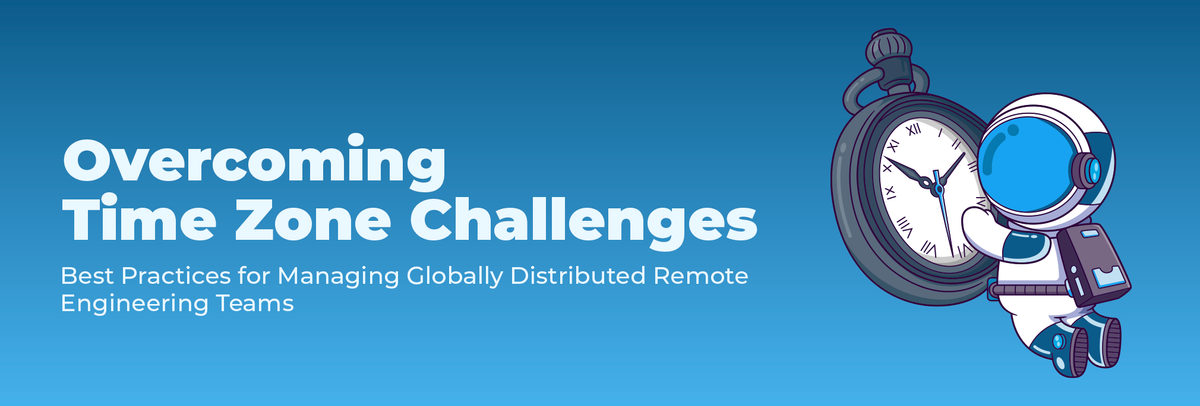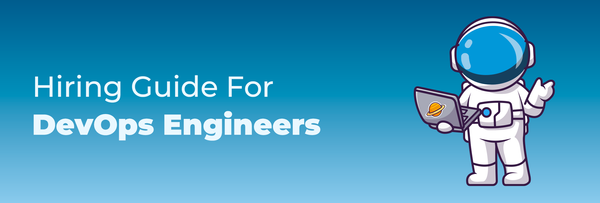Overcoming Time Zone Challenges: Best Practices for Managing Remote Engineering Teams Across Different Geographies

Ever feel like you're racing against the clock while your remote team members are already calling it a day?
Here's a startling fact to ponder: switching to remote work can save a staggering $11,000 per employee, yet time zone disparities can often feel like stumbling blocks on the path to success.
Effectively overseeing engineering teams distributed across various locations demands finesse and strategic planning.
Employing a multinational remote workforce, comprising individuals from diverse nations, offers companies invaluable benefits in terms of diversity, accessibility, and opportunities.
In fact, teams with a variety of backgrounds tend to make superior decisions in 87% of cases.
Nevertheless, this diversity presents its own array of challenges.
If not managed strategically, virtual teams can feel detached and isolated, hindering collaboration and productivity.
In this blog post, we're diving deep into time zone challenges, equipping you with the best practices to harmonize your team's efforts, boost productivity, and conquer geographical barriers like a pro.
Ready to unlock the secrets? Let's dive in!
Optimizing Remote Engineering Team Management Across Global Landscapes
- Establishing Flexible Work Schedules
Table 1
Embracing flexible work hours in remote settings has been empirically linked to reduced burnout, stress, and psychological discomfort, ultimately boosting job satisfaction.
By empowering team members to align their work schedules with their peak productivity hours—whether it's mornings, afternoons, evenings, or a blend of all three—their overall well-being and efficiency are significantly improved.
However, managing flexible schedules across multiple time zones presents unique challenges.
To navigate this complexity, encourage team members to carve out dedicated time within their regular schedules for check-ins or brief discussions on any arising issues and concerns.
This proactive approach fosters seamless communication and collaboration, ensuring timely resolutions despite geographical differences at remote engineering jobs.
- Leveraging Asynchronous Communication
For remote team managers, navigating synchronous communication pitfalls is all too familiar.
Late-night meetings across time zones, constant Slack notifications for instant responses, and unproductive gatherings are common woes.
This is where Asynchronous communication comes in when managing remote engineering teams that are geographically dispersed.
Unlike synchronous communication, which requires immediate responses, asynchronous communication allows team members to communicate and collaborate without the constraints of real-time interaction.
Research conducted by Slack reveals that asynchronous communication yields a remarkable time-saving benefit, reclaiming an average of three hours per week previously lost to in-person meetings and inefficient communication methods.
Embracing asynchronous methods can alleviate time zone constraints and enhance productivity, making it a vital consideration for effective remote team management.
Asynchronous communication is perceived as a productivity booster by 64% of individuals, primarily due to the absence of waiting periods for task completion.
One key advantage is its ability to accommodate diverse schedules and work preferences.
Team members can communicate and share information at their own pace, minimizing disruptions and allowing individuals to focus on their tasks without constant interruptions.
Additionally, asynchronous communication methods, such as email, project management tools, and documentation platforms, provide a permanent record of conversations and decisions, enabling team members to access information conveniently and refer back to it as needed.
Moreover, it fosters inclusivity by ensuring that all team members have an opportunity to contribute, regardless of their location or time zone.
Did you know that a majority of workers, totaling 52%, express a preference for asynchronous communication, with 42% regarding it as the forthcoming norm in the realm of employment?
- Tools for Seamless Remote Team Collaboration
Thanks to digitalization, several tools are available to streamline time zone management and ensure seamless communication across global teams between remote engineers.
Presenting World Time Buddy (WTB): a comprehensive solution encompassing a global clock, time zone converter, and meeting scheduling tool.
Ideal for frequent travelers, online meeting participants, and global communicators, it effortlessly compares multiple time zones, aids in scheduling, and facilitates business travel and market hour tracking.
Clockify offers time tracking and management features that enable teams to monitor their work hours across different time zones.
It provides visual representations of team members' availability and schedules, making it easier to coordinate meetings and project deadlines.
Calendly simplifies scheduling by allowing users to share their availability and let others book meetings based on their preferred time slots.
It automatically adjusts for time zone differences, eliminating the need for manual conversions and reducing scheduling conflicts.
Slack offers various features to facilitate communication across time zones, such as setting customized notification preferences and integrating time zone bots that display local times for team members.
Additionally, Slack's asynchronous communication capabilities enable teams to collaborate effectively without requiring immediate responses.
Google Calendar allows users to set up events and meetings while automatically adjusting for time zone differences.
It also offers features like world clocks and time zone support, making it easier for team members to coordinate schedules and plan meetings across different regions.
By leveraging these tools, remote engineers can overcome time zone challenges and enhance collaboration, ultimately improving productivity and project outcomes.
- Organize Consistent Meetings
Establishing a single designated time zone for project activities aids in maintaining team alignment.
All team members adjust their schedules accordingly by scheduling regular meetings in this designated time zone, fostering clarity and synchronization regardless of their geographical locations.
Loneliness emerged as a significant challenge for 21% of remote workers in their remote work experiences.
This is where remote team gatherings play an important role in mitigating feelings of isolation among remote workers, fostering a sense of inclusion and cohesion within the team dynamic.
Leveraging meeting tools like Zoom, Microsoft Teams, or Google Meet facilitates seamless communication and collaboration during these gatherings, further strengthening team bonds between remote engineers and management.
- Promote Cultural Understanding and Respect
In international remote teams, expect colleagues from diverse backgrounds with unique holidays and customs, which can complicate communication and collaboration.
Fostering respect and cultural awareness is vital, educating team members not only on time zones but also diverse cultures.
Utilizing time zone management tools to ascertain colleagues' current times before initiating discussions is advisable.
Additionally, varying off days across countries require careful consideration, especially in large and diverse teams.
A shared, updated calendar maintained by the entire team can address this, enhancing transparency and communication.
Ultimately, providing an inclusive experience for all team members, regardless of location or preferences, is paramount for effective remote team management.
Collaborating to navigate global schedules ensures mutual benefit and organizational success.
Let's delve into the success story of a company that adeptly managed a remote team of engineers.
Case Study: Dell's Remote Work Success with Connected Workplace
Curious about how to build and manage remote engineering teams?
Here's how Dell has been doing it all along.
Explore this case study for practical insights and real-world guidance on effective team building in a remote setting.
Company Background
Dell, a global technology leader, recognized the importance of adapting to the evolving work landscape and implemented the Connected Workplace program to facilitate remote work.
Challenge
Dell faced the challenge of running remote engineering teams dispersed across different geographies.
Coordinating schedules, ensuring effective communication, and maintaining productivity amidst time zone differences posed significant obstacles.
Solution
Dell embraced the Connected Workplace program, emphasizing flexibility and seamless integration of remote and flexible work into its business strategy.
Key components of their approach included:
Flexible Work Program Implementation: Dell prioritized the adoption of a flexible work program, empowering employees to work remotely and encouraging self-organization.
Management Support for Flexibility: Management led by example by maintaining flexible schedules, and fostering trust in team members' ability to manage their work effectively.
Results
Dell's commitment to remote work and flexible scheduling yielded significant results:
Improved Remote Work Organization: The implementation of the Connected Workplace program enabled Dell to effectively organize remote work, leading to enhanced collaboration and productivity.
Recognition as an Ethical Company: Dell's success in managing remote teams contributed to its recognition as one of the world's most ethical companies, highlighting the positive impact of its remote work initiatives.
By embracing remote work practices through the Connected Workplace program, Dell successfully navigated time zone challenges and optimized remote team collaboration.
The company's commitment to flexibility and trust in its employees' ability to self-organize played a crucial role in achieving remote work success across different geographies.
As organizations continue to adapt to remote work environments, Dell's case serves as a testament to the effectiveness of implementing best practices for managing remote working engineering teams across diverse locations.
Unlock Success with Teamo: Your Gateway to Exceptional Talent
Are you struggling to find top-tier software developers to propel your business forward?
Say goodbye to recruitment headaches and skyrocket your success with Teamo's talent solution.
Access pre-screened, high-caliber developers from emerging markets seamlessly integrated into your remote development team.
With Teamo, enjoy seamless integration, fast and affordable solutions, and an extensively vetted talent pool.
Join forces with your superteam of 10x talent and grow fearlessly towards your business goals.
FAQs
- What is the definition of a time zone in geography?
In geography, a time zone is a region of the Earth that observes a uniform standard time for legal, commercial, and social purposes.
Time zones are primarily based on the Earth's rotation and divided longitudinally, with each zone roughly 15 degrees of longitude apart.
The purpose of time zones is to coordinate timekeeping across different regions, ensuring that clocks in adjacent areas are relatively synchronized with each other.
Time zones are typically defined by their offset from Coordinated Universal Time (UTC) or Greenwich Mean Time (GMT), with adjustments made for factors such as daylight saving time.
- How would you manage a team that sits across multiple countries?
Managing remote engineering teams spread across different geographies presents a unique set of challenges, particularly when it comes to navigating the complexities of varying time zones.
Remote engineering jobs can often suffer from coordination hiccups, communication delays, and reduced cohesion due to these time differences.
However, with thoughtful strategies and best practices, these obstacles can be effectively overcome, enhancing productivity and team dynamics.
This involves prioritizing clear communication, regular check-ins using video conferencing tools, leveraging technology for collaboration, understanding cultural differences, accommodating diverse time zones, fostering unity through virtual team-building activities, and recognizing individual contributions.
Regularly reviewing and adapting strategies based on feedback ensures team cohesion and productivity.
- What is the biggest challenge of managing a remote workforce?
A primary obstacle in managing remote engineering jobs lies in upholding trust.
Findings from a recent Microsoft survey reveal that 85% of managers express skepticism regarding their employees' productivity levels when working remotely.
- How can we implement reverse-engineering productivity for remote teams in our organization?
To implement reverse-engineering productivity for remote teams, start by identifying remote teams within or outside your organization that are known for their high productivity.
Study their workflows, communication patterns, and technology use.
Next, adapt these insights to fit your team’s specific needs, ensuring that each strategy aligns with your organizational culture and goals.
This iterative process involves trial, feedback, and customization to optimize productivity.




